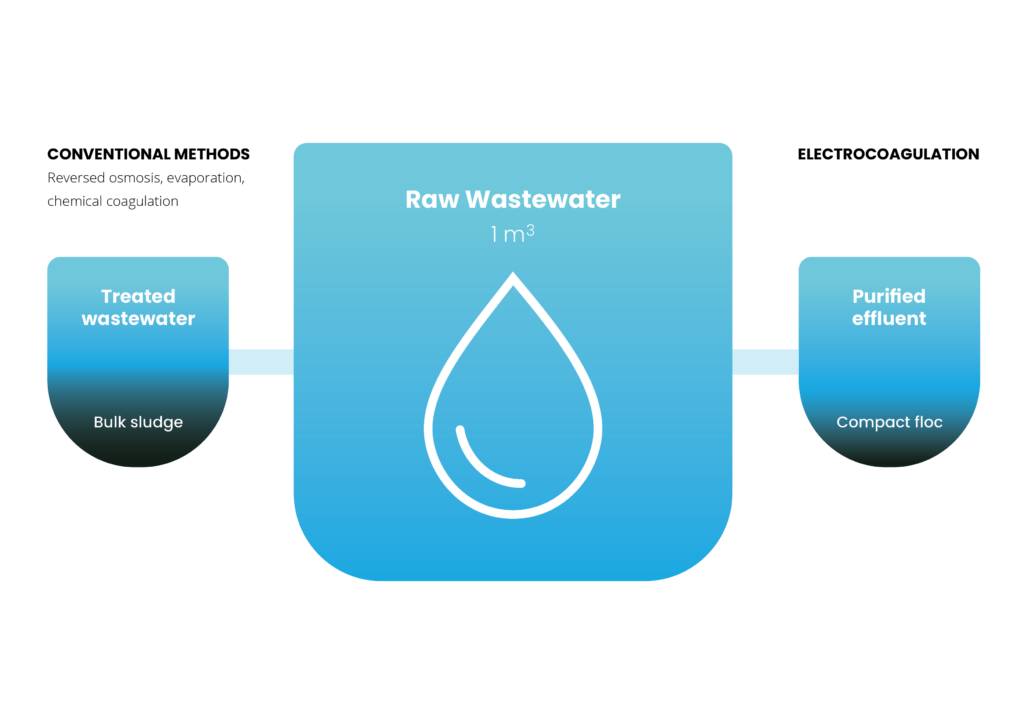Begär offert.

Elektrokoaguleringsteknik för överlägsen avloppsrening
Elektrokoagulering är en primär reningsmetod för avloppsvatten som liknar den allmänt använda kemiska koaguleringstekniken. Kemisk koagulering i sig är en mycket mångsidig process som tar bort en stor del av de vanligt förekommande föroreningarna i avloppsvatten. Processen utförs vanligtvis i stora bassänger. Termen "koagulering" hänvisar till förmågan hos multipelladdade metalljoner att bilda hydroxokomplex som attraherar lösta föroreningar för att adsorbera på komplexets yta på ett signifikant substökiometriskt sätt och sedan tillsätta en flockningspolymer för att bilda större komplex.
Vid kemisk koagulering uppnås koaguleringen genom tillsats av en starkt sur och frätande vattenlösning av t.ex. järn- eller aluminiumklorid följt av en neutralisering med användning av natriumhydroxid. Vid elektrokoagulering uppnås koaguleringen genom att låta en likström lösa upp en offerelektrod av metall över tiden. I denna process bildas hydroxidjon som motjon, vilket utesluter behovet av neutralisering och inte tillsätter någon kloridjon till lösningen som vanligtvis är fallet vid kemisk koagulering. Vätgas bildas också i den elektrokemiska processen.
Genom att undvika starka kemikalier och producera färre biprodukter anpassar elektrokoaguleringstekniken sig till den växande efterfrågan på hållbara metoder för avloppsvattenrening. Det är ett idealiskt val för industrier som söker effektiva, miljövänliga lösningar för att möta strikta miljöföreskrifter och samtidigt bibehålla kostnadseffektiviteten
The Principles of Coagulation
The main mechanism at work, regardless if EC or traditional flocculation with chemicals is used, is coagulation. It is without doubt one of the most important physio-chemical reactions used in water treatment. Simplified, the various pollutants in water, suchas ions (heavy metals) and colloids (organic andinorganic), are basically held in solution by repulsive electrical charges. The addition of ions with opposite charges destabilizes the colloids, allowing them to coagulate. Such coagulation occurs regardless of if the coagulation is achieved by means of adding achemical coagulant or by utilisation of EC technology.

Fördelar med elektrokoagulering jämfört med kemisk koagulering
In traditional chemical coagulation, commonly used agents include aluminum sulfate, polyaluminum chloride, and ferric chloride—substances that have been staples in wastewater treatment for decades.
Electrocoagulation, however, operates through a fundamentally different mechanism. As previously mentioned, it generates coagulants in situ through the electrolytic oxidation of a suitable anode material. During this process, charged ionic species in the wastewater react with oppositely charged ions or with metallic hydroxide flocs that form directly in the effluent. The effectiveness of electrocoagulation is further enhanced by several concurrent side reactions—most notably, the production of microhydrogen bubbles on the cathodes. These tiny bubbles offer a large surface area for particles to adhere to, significantly boosting pollutant removal efficiency. Together, these reactions contribute to the distinct advantages of electrocoagulation, which can remove a wider range of contaminants than many conventional treatment methods.
Traditional chemical coagulation methods, where external chemicals are added to destabilize suspended particles and precipitate pollutants, have well-known limitations. One of the most significant drawbacks is the generation of large volumes of sludge with a high water content. This type of sludge is difficult to filter and dewater, making its treatment and disposal both challenging and costly—often forming one of the largest expenses in wastewater treatment operations, particularly when chemical coagulants are involved.
Additionally, chemical coagulation typically increases the total dissolved solids (TDS) content in the treated water, which can hinder water reuse and recycling in industrial applications.

Electrocoagulation offers numerous advantages over conventional chemical coagulation, including:
No need to handle hazardous chemical solutions or maintain large chemical storage tanks, improving safety and saving space.
Compact storage requirements for replacement electrodes or reactors, making it well-suited for remote locations and emergency response scenarios.
Production of dense, high-solids floc that is easier to dewater, reducing handling and disposal costs.
A higher yield of reusable, clean water without chloride contamination, facilitating on-site water recirculation.
Sludge generation is reduced by 5 to 10 times compared to chemical coagulation, leading to up to 50% lower operational costs.
These benefits position electrocoagulation as an efficient, cost-effective, and environmentally sustainable alternative for modern wastewater treatment systems.

The Benefits of AxoPur
är Mellifiqs tekniska anpassning av elektrokoagulationsteknologin. AxoPur-reaktorn säkerställer att allt avloppsvatten faktiskt passerar genom reaktorn och utsätts för ett elektriskt fält och en homogen behandling. Ytterligare rengöringsmekanismer som är integrerade i AxoPur inkluderar effekter av det elektriska fältet och bildandet av vätgas i den elektrokemiska reaktionen. Sammantaget är resultatet en utomordentligt effektiv rening av avloppsvatten med ett brett spektrum – en rening i ett steg.
Många elektrokoaguleringssystem fungerar batchvis och kräver betydande behandlingstider, vilket begränsar deras kapacitet. I motsats till detta är reaktionen i AxoPur-reaktorn omedelbar och systemet utformat för kontinuerlig drift, även om intermittent drift alltid är ett alternativ, om flödet inte skulle finnas där. Eftersom reaktionen är omedelbar har systemet ett kompakt fotavtryck. Det betyder också att vattnet kommer att hålla sin temperatur under hela processen.
AxoPur: Fördelar jämfört med allmän elektrokoagulation
AxoPur förbättrar avloppsvattenrening genom att se till att allt vatten passerar genom reaktorn för högre reningseffektivitet. Det tar bort ett bredare utbud av föroreningar, inklusive olja, fett, mikrober och PFAS, på grund av ytterligare mekanismer. Processen möjliggör snabba och enkla justeringar genom aktuella förändringar, och den behåller vattentemperaturen, vilket möjliggör värmeåtervinning när renat vatten recirkuleras.


